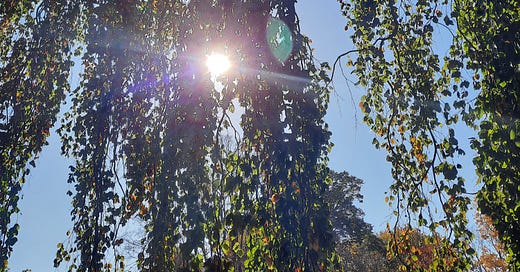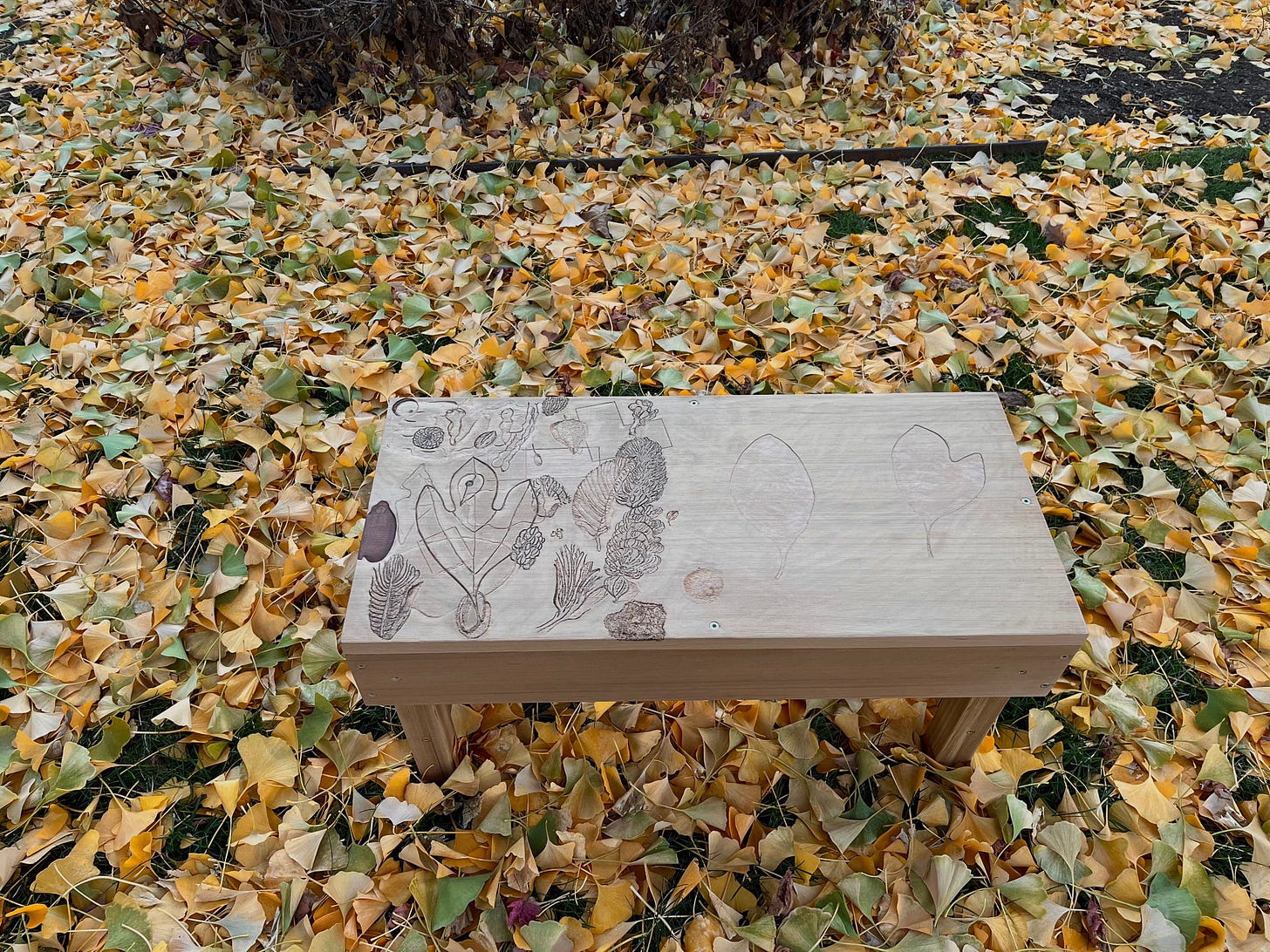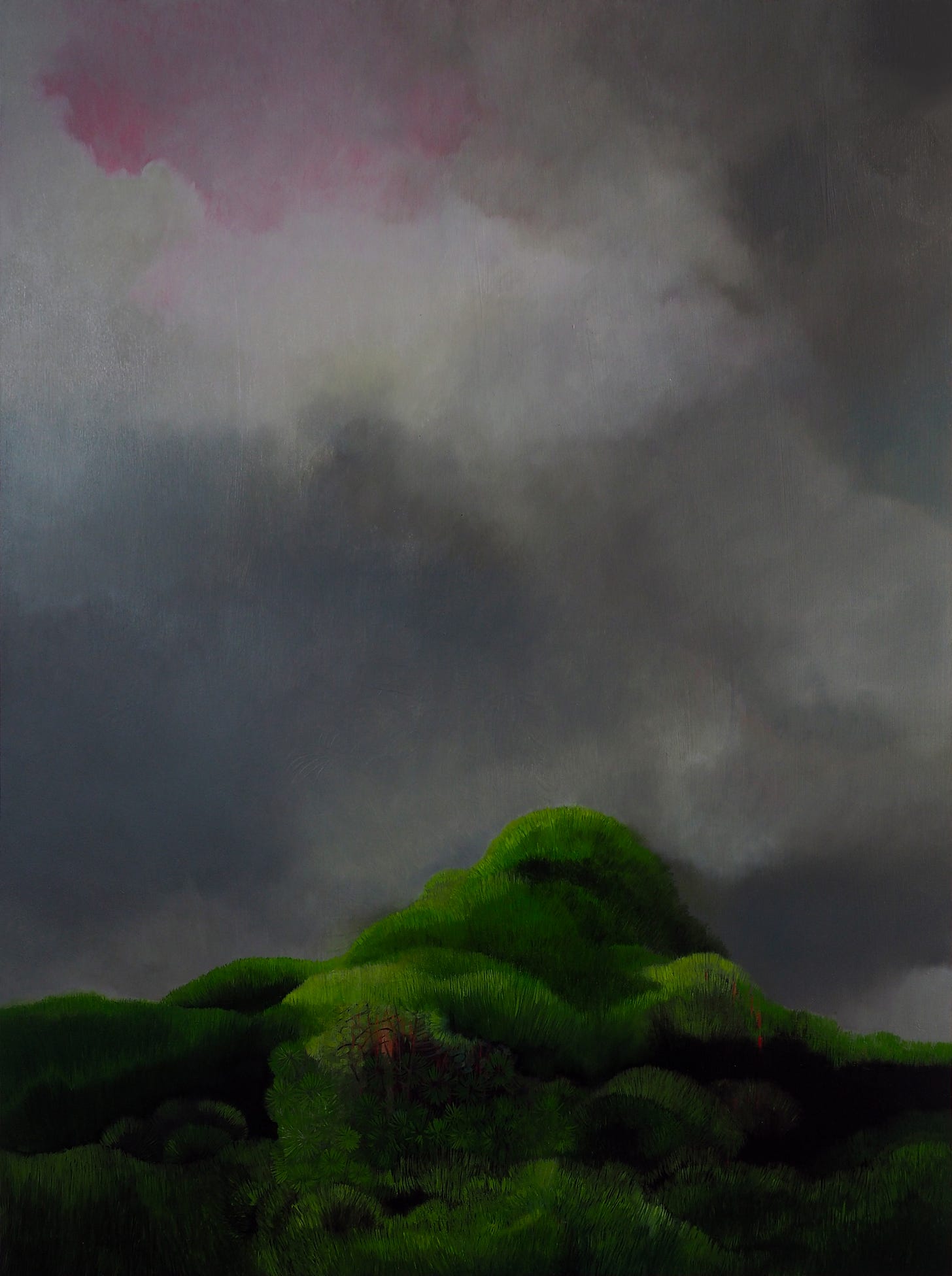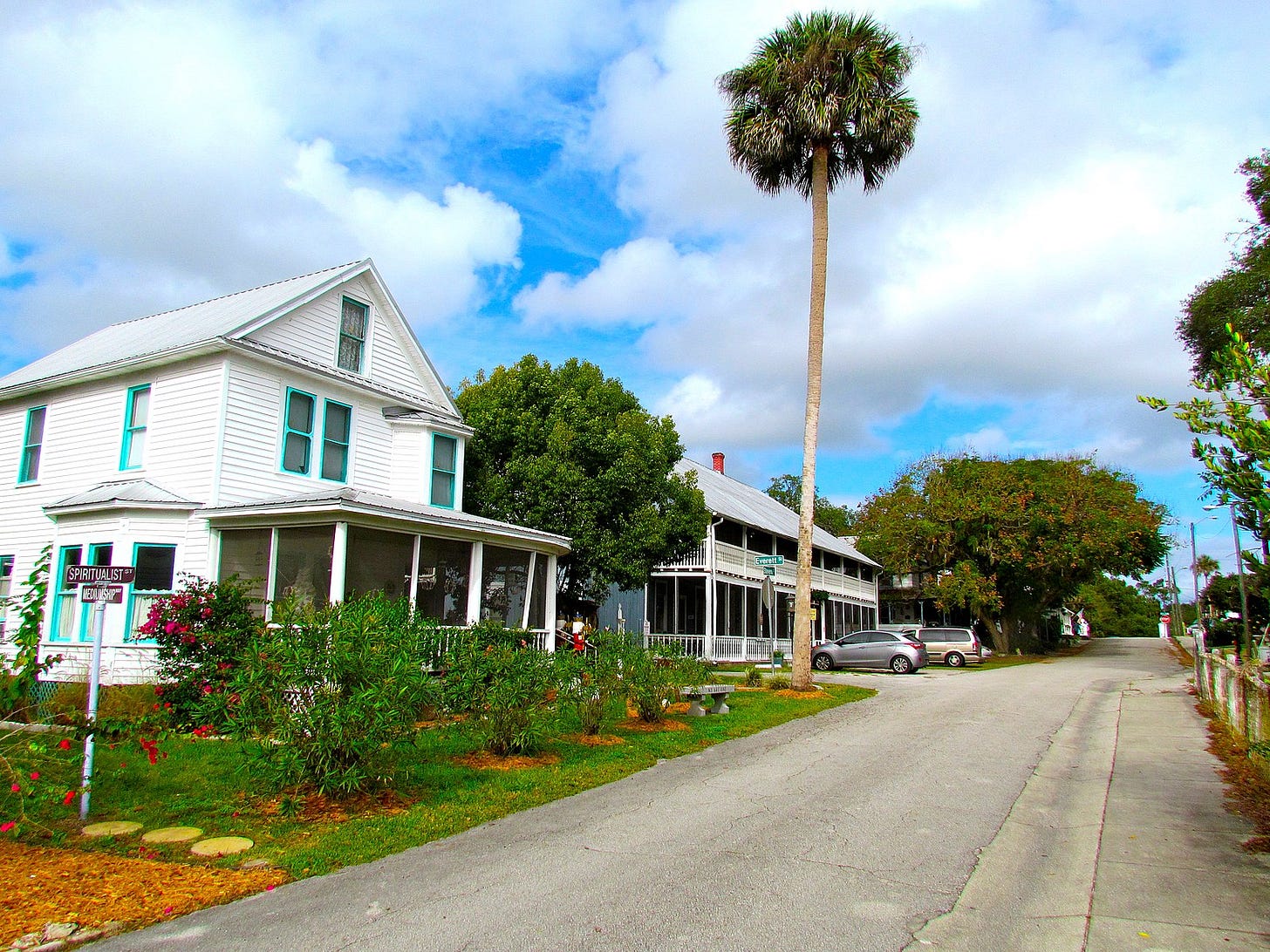Spirits and molecules
Chatting about life, death, and consciousness with Resa Blatman and Jill Slosburg-Ackerman at Mount Auburn Cemetery
On a diamond-bright Saturday in late October, painter Resa Blatman, an artist in residence at Mount Auburn Cemetery, was holding court in the Asa Gray Garden. Anyone could sit down and chat with her about death.
Before I met Resa, sculptor Jill Slosburg-Ackerman picked me up at the gate in her Subaru. We drove past the crowds to a quiet area. As artist in residence at the cemetery last year, Jill crafted lightweight mourning benches from cedar, carving or otherwise adorning seats and attaching handles. Last year, cemetery visitors could pick them up, carry them easily to a gravesite, and have a nice sit-down.
I spoke to Resa and Jill separately, but the conversations overlapped.
Jill made the benches in response to her own experience after her husband, James Sloss Ackerman, died on Dec. 31, 2016, and was buried along the Azalea Path at Mount Auburn. Visiting his grave in winter, she felt she needed to sit down, but the ground was often damp or snowy. Viewing art, moments of gravity and transcendence can compel her to sit, she said, and that extends beyond the gallery. The benches are examples of what she called “emotional pragmatism.“ Their function goes beyond a place to rest; a mourning bench has emotional or ritual resonance.
“It’s not the same as giving someone who needs solace a tool,” Jill said, as we settled on the benches beneath a weeping beech. “But they’re giving the opportunity to sit down, have a conversation, do a little bit of writing.”
Mount Auburn Cemetery has been around nearly for two centuries. “Before 1831, most Americans were buried in isolated plots or in crowded town graveyards. Mount Auburn’s founders had a new vision. They designed a tranquil, natural setting, well outside the city, to bury and commemorate the dead and to inspire and comfort the living,” according to the cemetery’s website. Mount Auburn has evolved with American attitudes toward death, but its mission remains the same. People visit to commemorate the dead; many seek communion. Some don’t even have to seek it.
“I came here once with someone who would jump the [cemetery] fence as a teenager, and they would see ghosts,” Jill said. “Some people are just tuned into that.”
That’s not Jill’s way. She thinks of what happens after death in terms of molecules. “My comfort is that my beloved dog is still out here in molecules,” she said.
I thought of my mother, who died in 2013 and would have ascribed to Jill’s viewpoint. Mom often had a wise-woman/guru effect on people, including me. When I was in my late 20s, my friend Willow asked my mom what she thought about life after death. Willow was the daughter of my mother’s best friend, Pat, who had died not long before.
Don’t go there, I thought reflexively as Willow spoke. I could be a bit of a guard dog, shielding my mother from questions I felt she had already, somehow, resolved. I knew Mom lived in the mystery. She had a Buddhist “only don’t know” philosophy about life, including about death, and that’s what she told Willow.
I have followed her lead. It seems very pragmatic to me. But pragmatism will only get you so far when someone close to you dies. That’s one reason we need mourning benches.
Pat was the first dear person I lost. She died suddenly of a massive heart attack at 60 – the age I am now. Warm, ebullient, open and emotional, she was my childhood provider of unconditional love. I was 23 when we lost her. The night she died, I dreamed she and I were at the top of the Hancock tower in Boston. She took off flying, and I sensed that everything would be all right.
It wasn’t, of course. Grief was foreign terrain to me and I blundered through it for months. But the dream helped me to feel that Pat, leastwise, was all right.
After my conversation with Jill, I wandered into the bountiful Asa Gray Garden and sat down with Resa. Two people were already deep in conversation with her about death when I arrived.
“So Cate,” Resa said, “you said you wanted to talk about life after death.” I thought of Willow and my mother. I hadn’t said that, and I demurred. But I was willing to talk about it.
Resa had sent me a link to the Netflix series “Surviving Death,” about near-death experiences, and I’d watched the first episode. The show tells remarkable stories. A medical doctor relates how, wildly, she was revived after drowning and being underwater for 30 minutes. During that time, she encountered comforting beings who clued her into something life-changing that would, and indeed did, happen years hence. There are also compelling interviews with professors at the University of Virginia School of Medicine’s Division of Perceptual Studies.
Right before the pandemic, Willow and I attended a séance at Cassadaga, a spiritualist camp in Florida. It’s a tiny town with narrow streets lined with 100-year-old bungalows. There’s a bookstore with a bulletin board covered with information about local mediums, available around every corner.
An official skeptic, I also had hope. I had a knot in my soul – to be precise, in my gut – about my mother. Her secrets and mysteries. All she did not talk about. Things I had not resolved with her before she died.
I’d already seen a medium who sensed a man in a military uniform hovering nearby – had my father been in the military? Well, yes. But if Dad were to appear out of the ether, it would be in a Brooks Brothers suit. This Cassadaga thing, I thought, was going nowhere fast. At the seance that night, 10 of us sat in a circle in a room lit only by a red light. The medium said he saw my grandmother sprinkling baking flour on me like fairy dust.
Yeah, right, I thought.
The night before heading to Mount Auburn Cemetery, I watched the first episode of “Surviving Death” with the same doubtful intrigue I’d approached Cassadaga. But as the episode unfolded, I felt the show butting up against my own well-worn ways of thinking, and began to see skepticism as the water I was swimming in. Hoary assumptions passed down by a supremely rational society and a Buddhist-leaning mother.
“In this culture, we are so influenced by a certain kind of thinking, a certain kind of science that considers it preposterous, or you’re woo-woo, if you think about this,” Jill had said. We had begun to walk, and found ourselves under a weeping Japanese pagoda tree.
I’ve kept my woo-woo under wraps for many years, and that silence has eaten at me. I went for a hike a couple of years ago with a journalist friend, and I declared, “I am woo-woo!” Meaning, in a journalistic context, that I experience things that simply cannot be fact-checked. That may sound obvious, but I felt like I was coming out of the closet.
“All these ideas about science seemed like a prize, but they’re also a protection from things,” Jill said.
We absolutely need science, we agreed.
“But it distances us,” she said.
The day after the séance, Willow and I attended a workshop on astral projection – out of body experiences – and lucid dreaming. If my dream about Pat had been lucid, I would have been aware enough to take flight after her from the Hancock’s roof.
My mother, a therapist, taught me to pay attention to my dreams. She led dream workshops I attended as a teenager. I respect the rich loam of the dream world, the possibilities of conjuring and collaboration with my unconscious, which can feel like a timeless, space that reaches far beyond me. Active imagination plays into my contemplative movement practice. With this context at the workshop, I found a road map. The teacher led us in a guided meditation through a wildflower field and into a temple. There, we lifted into the air and flew. When we came to ground, we found a door that opened into a garden. Waiting for us was someone we knew.
Mom. Just a wisp, but her.
She said to me, “You don’t have to take care of me anymore.”
When the meditation ended, the knot in my gut was gone.
“Everything about the universe is so fantastical, why wouldn’t our consciousness survive after we die?” Resa asked. “If we’re made of what the universe is made of, wouldn’t we go back to our home?”
She is a hospice volunteer. “I’m fascinated by what happens to us after we die,” she said. “I think it’s joyous. It can’t be worse than the horrors here on earth.”
The horrors on earth are indeed unrelenting and terrifying. But there are joys and tenderness here, there’s the sun and the grass and the glory of a warm day in late October, there’s love and touch and conversation. There are leaves that, having given up the ghost, spiral through the air. There is, I feel (and I see in Resa’s paintings and her death chats), a responsibility to show up with an open heart.
Maybe death is not so bad. It’s the fear of it, so enculturated in our finicky, sterile, violent society, that traps us. I believe that consciousness is not as linear as beginnings and endings, and death is an ending. That might be what eternity means. On this plane, we continue to love and engage with those we’ve lost. My relationship with my mother still opens and evolves. Did I encounter her as a separate entity during that guided meditation? Or was it simply active imagination leading me to healing I was ready for? Does it really matter?
Only don’t know. (Thank you, Mom).
Images: Weeping beech, photo by Cate McQuaid; Jill Slosburg-Ackerman “Mourning Bench,” 2022, 13x24x11”, cedar, courtesy Jill; Resa Blatman “Mossy Hill,” 2023, 24x18”, oil and acrylic on wood panel, courtesy Resa; photo of Cassadaga, Florida, by RobArtVan courtesy Wikimedia Commons; weeping Japanese pagoda tree, photo by Cate McQuaid; Asa Gray Garden, Mount Auburn Cemetery, photo by Cate McQuaid.
Correction: An earlier version of this essay said Jill Slosburg-Ackerman’s mourning benches are available to borrow at Mount Auburn Cemetery. They were, but that’s no longer the case. Now they’re back with Jill; anyone who wants to borrow one or sit with her for a conversation at the cemetery can contact her via Instagram messaging.










Thank you for the eloquent writing. It made me feel intimate with your mom--as I do in dreams. I feel surrounded by her molecules in this house.
Woo-woo!